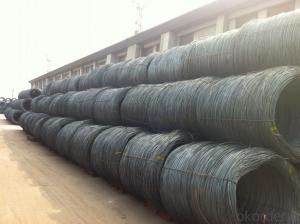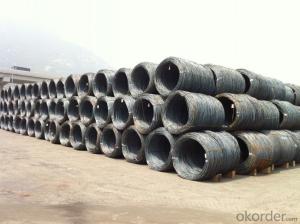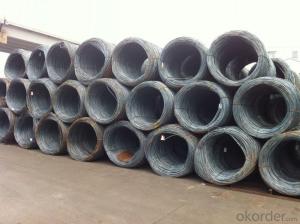SAE1008 Wire Rods Best Quality and Price and Hot Rolled
- Loading Port:
- Tianjin
- Payment Terms:
- TT OR LC
- Min Order Qty:
- 25 m.t.
- Supply Capability:
- 20000 m.t./month
OKorder Service Pledge
OKorder Financial Service
You Might Also Like
Item specifice
Grade: SAE1008 Standard: ASTM
Diameter: 5.5mm, 6.5mm, 7mm, 8mm, 9mm, 10mm, 11mm, 12mm
Alloy or Not: Alloy
Technique: Hot Rolled Place of Origin: China Mainland
Chemical Composition:
Please kindly find our chemistry of our material based on SAE1008 as below for your reference:
Grade | Chemical Composition (%) | |||||
C | Mn | S | P | Si | B | |
SAE1008 | 0.10max | 0.30-0.50 | 0.050max | 0.040max | 0.30max | 0.0008min |
Mechanical properties | ||||||
Yield strength(N/mm2) | Tensile strength(N/mm2) | Elongation (%) | ||||
≥195 | 350-380 | ≥32 | ||||
Usage and Applications of Wire Rod:
After hot-rolled the products shaped into coil and delivery as finished product, including round, square,rectangular, hexagonal and so on. Since most of the products are round, it is generally called wire rod. Carbon steel wire rod is widely used in construction and manufacturing. Carbon steel wire rod is mainly used for reinforcement of reinforced concrete and welded structure or reprocessed (roberts , nail, etc.) materials, especially used to produce wire drawing, welding electrode, nails, spring, electronic, precise machinery parts and so on.
Packaging & Delivery of Wire Rod:
Packaging Detail: products are packed in coil and then shipped by container or bulk vessel
Each coil weight: About 2.05MT
Delivery Detail: within 45 days after received deposit or LC.
Label: to be specified by customer, generally, each bundle has 1-2 labels
Trade terms: FOB, CFR, CIF
FAQ:
Q1: How soon can we receive the product after purchasement?
A1: Within three days of placing an order, we will begin production. The specific shipping date is dependent upon international and government factors, but is typically one month.
Q2: How do you guarantee the quality of our products?
A2: We have established an advanced quality management system which conducts strict quality tests at every step, from raw materials to the final product. At the same time, we provide extensive follow-up service assurances as required.
Q3: Why buy Materials & Equipment from OKorder.com?
A3: All products are carefully selected from China's most reliable manufacturing enterprises. Through its ISO certifications, OKorder.com adheres to the highest standards and a commitment to supply chain safety and customer satisfaction.
Images of Wire Rod
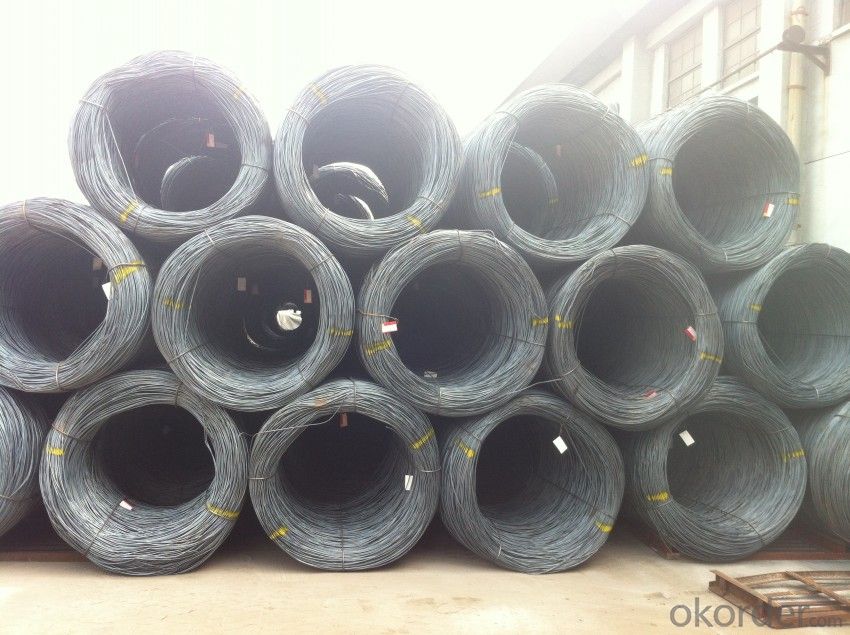
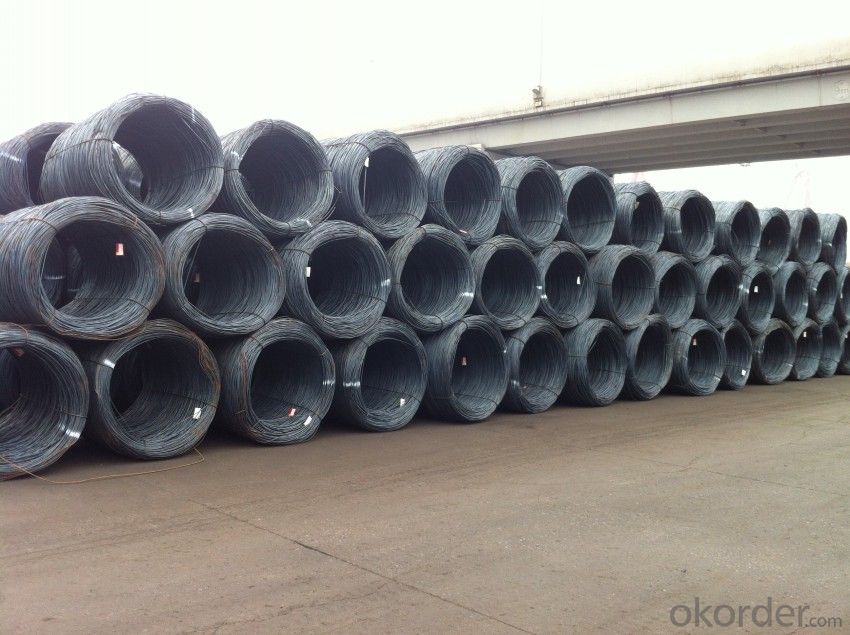
- Q:How is steel wire rod stored at the customer's site?
- Steel wire rod is typically stored at the customer's site in a variety of ways depending on the specific requirements and conditions. One common method is to store the steel wire rod on racks or pallets, especially if the customer has a large quantity of rods. These racks or pallets are usually placed in an organized manner to ensure easy accessibility and safety. In addition to racks or pallets, steel wire rod can also be stored in bundles or coils, particularly when the customer requires smaller quantities or wants to maintain the wire rod's shape and integrity. These bundles or coils are often secured with straps or bands to prevent any movement or damage during storage or transportation. Furthermore, the storage area for steel wire rod should be dry, clean, and well-ventilated to prevent corrosion or other forms of damage. Proper protection measures, such as covering the wire rod with tarps or plastic sheets, may be employed to shield it from dust, moisture, or other environmental elements. It is important for customers to follow any specific storage instructions provided by the manufacturer or supplier to ensure the longevity and quality of the steel wire rod. This may include guidelines on temperature control, stacking limitations, or the use of specialized equipment for handling and storage. Overall, the storage of steel wire rod at the customer's site should prioritize safety, accessibility, and protection to guarantee the optimal performance and usability of the product.
- Q:What are the main factors influencing the choice of steel wire rod production process?
- Several key factors influence the selection of the steel wire rod production process. Firstly, the quality requirements of the final product play a vital role. Each production process has its own capabilities in producing steel wire rods with specific properties such as strength, ductility, and surface finish. The desired characteristics of the wire rod will determine the appropriate production process. Secondly, the cost-effectiveness of the production process is an important consideration. The overall cost of production can be significantly affected by factors like energy consumption, raw material utilization, and labor requirements. It is crucial to evaluate the efficiencies and costs of different processes to make the most economical choice. Moreover, the availability and cost of raw materials also impact the selection of the production process. Steel wire rods can be made from various types of steel, including carbon steel, alloy steel, or stainless steel. The choice of raw material depends on factors such as required mechanical properties, availability, and cost. The production process must be compatible with the chosen raw material. Another factor to consider is the production capacity and scalability of the process. Some processes are more suitable for small-scale production, while others are better suited for large-scale manufacturing. The desired production volume and scalability requirements must be taken into account to ensure the chosen process can meet the production demands. In addition, environmental considerations can also influence the choice of production process. Some processes may generate more waste or emit higher levels of pollutants compared to others. Companies may prioritize sustainable and environmentally friendly production methods, leading them to select a process that minimizes environmental impact. Overall, the selection of the steel wire rod production process is influenced by factors such as desired product quality, cost-effectiveness, availability and cost of raw materials, production capacity and scalability, and environmental considerations. A careful evaluation of these factors is necessary to choose the most suitable production process for a specific application.
- Q:How does the chemical composition of steel wire rod affect its properties?
- The chemical composition of steel wire rod greatly affects its properties. The proportions of various elements in the steel, such as carbon, manganese, and phosphorus, determine its strength, ductility, and corrosion resistance. Higher carbon content results in increased strength but reduced ductility. Manganese improves strength and hardness, while phosphorus enhances machinability. Additionally, the presence of impurities can weaken the steel and make it more prone to corrosion. Therefore, controlling the chemical composition of steel wire rod is crucial to achieving desired properties for specific applications.
- Q:What are the main factors influencing the choice of steel wire rod payment terms?
- The choice of payment terms for steel wire rod can be influenced by several key factors. One primary factor is the buyer's financial stability and creditworthiness. If the buyer is financially strong, the seller may be more inclined to offer favorable payment terms, such as longer payment periods or installment options. Conversely, if the buyer has a weak credit history or financial instability, the seller may require stricter payment terms, like upfront payment or shorter payment periods. Market conditions and competition also play a role in determining payment terms. In a highly competitive market with numerous suppliers, the seller may need to provide more flexible payment options to attract buyers. This could include deferred payment or payment upon delivery. On the other hand, in a market with limited suppliers or high demand, the seller may have more bargaining power and can impose stricter payment terms. The nature of the business relationship between the buyer and seller is another crucial consideration. If the buyer and seller have a longstanding relationship with a history of successful transactions, the seller may be more inclined to offer favorable payment terms as a sign of trust and loyalty. Additionally, the volume and frequency of purchases can also influence payment terms. Buyers who consistently buy large quantities of steel wire rod may have more leverage in negotiations and can secure more favorable payment terms. Lastly, external factors such as economic conditions, currency fluctuations, and government regulations can also impact payment terms. During times of economic uncertainty or currency volatility, sellers may exercise more caution and require stricter payment terms to mitigate risk. Similarly, government regulations pertaining to international trade or finance can also affect payment terms. In summary, the choice of payment terms for steel wire rod is influenced by factors such as the buyer's financial stability, market conditions, the nature of the business relationship, and external factors like economic conditions and government regulations.
- Q:What are the different cleanliness testing methods for steel wire rod?
- There are several cleanliness testing methods for steel wire rod that are commonly used in the industry. These methods help determine the level of impurities and contaminants present on the surface of the wire rod, ensuring its quality and suitability for various applications. Some of the different cleanliness testing methods for steel wire rod include: 1. Visual Inspection: This is the simplest and most basic cleanliness testing method. It involves a visual examination of the wire rod's surface for any visible impurities such as scale, rust, or foreign particles. 2. Magnetic Particle Inspection (MPI): MPI is a non-destructive testing method that uses magnetic fields and iron particles to detect surface and near-surface defects on the wire rod. It is particularly effective in identifying cracks, seams, or other imperfections that may impact the integrity of the wire rod. 3. Eddy Current Testing: Eddy current testing is another non-destructive method that uses electromagnetic induction to detect surface defects and variations in conductivity. It can identify defects such as cracks, pits, or variations in material composition that can affect the wire rod's quality and performance. 4. Ultrasonic Testing: Ultrasonic testing involves the use of high-frequency sound waves to detect internal and surface defects in the wire rod. It can identify flaws such as voids, inclusions, or discontinuities that may compromise the wire rod's structural integrity. 5. Chemical Analysis: Chemical analysis involves the use of various laboratory techniques to determine the chemical composition of the wire rod. It can identify impurities, such as sulfur, phosphorus, or other elements that may affect the wire rod's mechanical properties and corrosion resistance. 6. Microscopic Examination: Microscopic examination involves the use of optical or electron microscopes to magnify the wire rod's surface and analyze it at a microscopic level. It can help identify surface defects, inclusions, or other anomalies that may affect the wire rod's performance. These different cleanliness testing methods for steel wire rod provide valuable insights into the quality and suitability of the material for its intended use. Manufacturers and end-users can utilize these methods to ensure that the wire rod meets the required cleanliness standards and specifications.
- Q:How is steel wire rod used in the manufacturing of wire for conveyor belts?
- Steel wire rod is an essential component in the manufacturing of wire for conveyor belts. The process begins with the production of steel wire rod, which is typically done through a hot rolling process. This involves heating the steel billets to a high temperature and passing them through a series of rolling mills to reduce their diameters and increase their lengths. Once the steel wire rod is produced, it undergoes further processing to transform it into wire suitable for conveyor belts. This process involves drawing the steel wire rod through a series of dies, which progressively reduce the diameter of the wire while increasing its length. This drawing process helps to improve the wire's strength, ductility, and surface finish. The wire obtained from the steel wire rod is then typically coated with a protective layer to enhance its durability and resistance to corrosion. This coating can be done using various methods such as galvanization or applying a polymer coating. After the wire is coated, it is ready to be woven or welded into the desired configuration to form the conveyor belt. The wire can be woven together in a mesh pattern, creating a flexible and sturdy belt that can move materials smoothly along a conveyor system. Alternatively, the wire can be welded together to form a solid belt, which is often used for heavy-duty applications. In both cases, the strength and quality of the wire used for conveyor belts are crucial for ensuring the belt's reliability and longevity. Steel wire rod provides the necessary strength and structural integrity required to withstand the demanding conditions of conveyor belt applications, such as high tension, heavy loads, and continuous operation. Overall, steel wire rod plays a vital role in the manufacturing of wire for conveyor belts. It serves as the raw material from which the wire is produced and provides the necessary strength and durability to ensure the smooth and efficient operation of conveyor systems across various industries.
- Q:What are the different types of steel wire rod annealing atmospheres?
- There are several different types of steel wire rod annealing atmospheres that can be used depending on the desired outcome and specific requirements of the process. These atmospheres can vary in terms of the gases used and the conditions maintained during annealing. 1. Nitrogen Atmosphere: Nitrogen gas is commonly used in steel wire rod annealing processes. It is an inert gas that helps to protect the material from oxidation and decarburization. Nitrogen atmosphere creates a stable environment for annealing, ensuring consistent and controlled heat treatment. 2. Hydrogen Atmosphere: Hydrogen gas is another commonly used annealing atmosphere for steel wire rods. Hydrogen helps to minimize surface oxidation and can also aid in the removal of any surface contaminants or impurities. It promotes a clean and bright surface finish on the wire rod. 3. Vacuum Atmosphere: Vacuum annealing involves creating a low-pressure environment by removing air and other gases from the annealing chamber. This atmosphere prevents oxidation and allows for precise control over the annealing process. Vacuum annealing is often used for high-quality wire rods that require minimal surface defects and improved mechanical properties. 4. Inert Gas Mixtures: In some cases, a mixture of inert gases such as nitrogen and hydrogen may be used as an annealing atmosphere. This combination can provide the benefits of both gases, such as protection against oxidation and impurity removal. The specific mixture and ratios are determined based on the desired outcome and material requirements. 5. Controlled Atmosphere Furnaces: Controlled atmosphere furnaces allow for precise regulation of the annealing atmosphere by continuously monitoring and adjusting the gas composition. This enables the optimization of annealing conditions to achieve desired material properties and surface finishes. It is important to note that the choice of annealing atmosphere depends on the specific steel composition, desired properties, and end-use application of the wire rod. By carefully selecting the appropriate atmosphere, steel wire rods can undergo a controlled heat treatment process that enhances their mechanical properties, surface quality, and overall performance.
- Q:What are the different surface defects that can affect the fatigue life of steel wire rod?
- Some common surface defects that can affect the fatigue life of steel wire rod include surface cracks, pitting corrosion, surface decarburization, and surface roughness. These defects can weaken the structural integrity of the wire rod, leading to premature failure under cyclic loading conditions.
- Q:What are the main factors influencing the choice of steel wire rod after-sales service?
- There are several key factors that influence the selection of after-sales service for steel wire rods. Firstly, the quality of the service provided is of utmost importance. Customers expect prompt and effective support, including timely responses to inquiries, technical assistance, and problem resolution. A dependable after-sales service ensures customer satisfaction and fosters trust in the supplier. Secondly, the availability and accessibility of spare parts and components are crucial considerations. Customers anticipate suppliers to have readily available stocks of spare parts to swiftly address any issues with the steel wire rods. This minimizes downtime and guarantees uninterrupted production. In addition, the expertise and knowledge of the after-sales service team are critical factors. Customers value suppliers who employ well-trained and experienced service technicians capable of providing expert guidance and advice. This assists customers in optimizing the performance of the steel wire rods and addressing any operational challenges they may face. Another influential factor is the cost-effectiveness of the after-sales service. Customers seek service packages that offer value for money, including reasonable prices for spare parts, maintenance contracts, and repair services. A cost-effective after-sales service ensures that customers receive the necessary support without incurring significant additional expenses. Furthermore, the geographical coverage and response time of the after-sales service team are taken into account. Customers prefer suppliers with extensive service networks, enabling them to receive support even in remote locations. Additionally, a quick response time is crucial for minimizing production downtime and maintaining efficient operations. Lastly, customer feedback and reputation also impact the selection of after-sales service for steel wire rods. Positive testimonials and references from existing customers can instill confidence in potential buyers. Therefore, suppliers who consistently receive positive feedback and have a strong reputation for excellent after-sales service are more likely to be favored. In conclusion, the choice of after-sales service for steel wire rods is influenced by factors such as service quality, spare part availability, service team expertise, cost-effectiveness, geographical coverage, and reputation. By considering these factors, customers can make informed decisions and select suppliers that meet their after-sales service expectations.
- Q:How are steel wire rods used in the manufacturing of welding wires?
- Welding wires are manufactured from steel wire rods, which are essential components in the manufacturing process. Typically made of carbon steel, these wire rods undergo various manufacturing processes to transform them into welding wires. To begin with, the steel wire rods are cleaned to eliminate impurities and contaminants. This step ensures that the resulting welding wires meet high-quality standards and are suitable for welding applications. The cleaning process may involve techniques such as acid pickling or mechanical descaling. Once cleaned, the wire rods are drawn through a series of dies to reduce their diameter to the desired size. This drawing process elongates and thins the rods by pulling them through progressively smaller dies. The result is a more uniform wire diameter, which is crucial for precise welding applications. After achieving the desired diameter, the wire rods may undergo additional treatments depending on their intended use. For instance, heat treatment processes like annealing can be applied to enhance the wires' mechanical properties and reduce internal stresses. Next, the wire rods are typically coated with materials like copper to improve their electrical conductivity and provide corrosion resistance. This coating also enhances the weldability of the wires. Finally, the coated wire rods are spooled onto reels or coils to be used in various welding processes. These welding wires are then supplied to industries and professionals engaged in welding applications, such as construction, automotive, or manufacturing. In conclusion, the manufacturing of welding wires involves a series of processes, including cleaning, drawing, heat treatment, coating, and spooling. These wires play a crucial role in welding applications, offering a reliable and efficient means of joining metals together.
1. Manufacturer Overview |
|
|---|---|
| Location | |
| Year Established | |
| Annual Output Value | |
| Main Markets | |
| Company Certifications | |
2. Manufacturer Certificates |
|
|---|---|
| a) Certification Name | |
| Range | |
| Reference | |
| Validity Period | |
3. Manufacturer Capability |
|
|---|---|
| a)Trade Capacity | |
| Nearest Port | |
| Export Percentage | |
| No.of Employees in Trade Department | |
| Language Spoken: | |
| b)Factory Information | |
| Factory Size: | |
| No. of Production Lines | |
| Contract Manufacturing | |
| Product Price Range | |
Send your message to us
SAE1008 Wire Rods Best Quality and Price and Hot Rolled
- Loading Port:
- Tianjin
- Payment Terms:
- TT OR LC
- Min Order Qty:
- 25 m.t.
- Supply Capability:
- 20000 m.t./month
OKorder Service Pledge
OKorder Financial Service
Similar products
New products
Hot products
Related keywords
